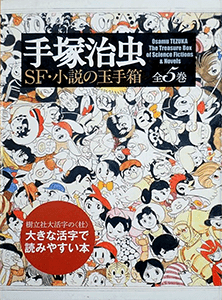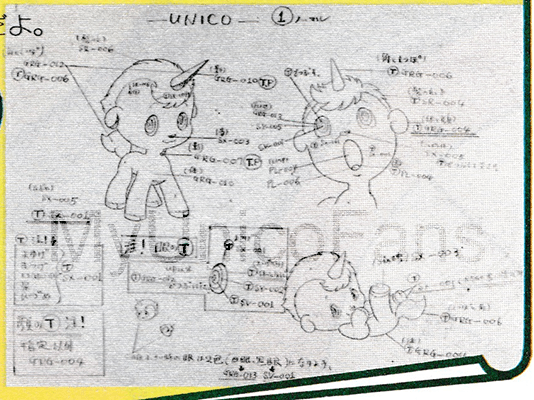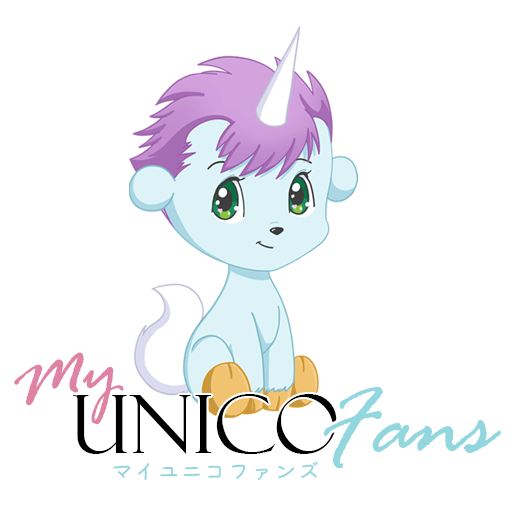
First published in the Osamu Tezuka The Treasure Box of Science Fictions & Novels set in 2011, they later republished the manuscript in Osamu Tezuka Scenario Aggregation in 2017. This script is simply titled “Unico,” but was written for the pilot episode, Unico: Black Cloud and White Feather. Unlike the other two scripts that come after this one, there are minor differences between the finished animation and what is written. Before the script begins, there is a poem or lyrics. While this is not in the pilot episode, the first sentence appears in an actual song used in the animation for “Where did you come from, Unico?” which may have sprouted from the small lyrics which we’ve added below:
| Japanese | Romaji | Translation |
|---|---|---|
| どこから来たの ユニコ どこへ行くの ユニコ だれも知らない ひとりぼっちのユニコ あなたの愛が ユニコをあなたにあわせます | Doko kara kita no Unico Doko e iku no Unico Daremo shiranai Hitoribocchi no Unico Anata no ai ga Unico o anata ni awasemasu | Where did you come from, Unico? Where are you going, Unico? Nobody knows Lonely Unico Your love Will connect Unico to you |

After reading the script, we noticed how close it is to the actual animation. Then there are the name changes. Most fans are familiar with both comic and animation versions of the sickly girl named Chiko. In this script, she’s named Lala (ララ Rara). Since this was a draft, it could have been a placeholder name, but we are uncertain. Another character we noticed a slight name change is Garappachi, also known as Nezumi (meaning mouse or rat). While often written in Japanese as ネズミ (Nezumi), his name appears as ノネズミ (Nonezumi) in the script, which is a specific type of mouse endemic to Japan, simply called the large Japanese field mouse in English. This isn’t a tremendous change, but interesting to note.
If you’ve watched the pilot episode, this script and the animation will look very similar. The ending to this script differs from both anime and manga versions, but still concludes with Zephyrus of the West Wind taking Unico off again.
Retelling written by Xellis (6/11/23):
One night, a strange animal staggered up a hill. It was exhausted and hungry, about to collapse. Nearby, it spotted a dog eating something, but when it came closer, the dog barked and chased it away. Then an owl attacked the poor animal, and it landed in the ditch. This is where Nonezumi spotted the creature, mistaking it for a cat at first. The animal asked the mouse for food, but Nonezumi told the creature that everyone is struggling to find food. He has to find food for his children after his wife accidentally ate poison and died. Still, he gave the poor animal a small bit of food and asked where it was going. The animal didn’t know where to go, and so the mouse told the beast to follow him.
The mouse led the other animal to a shabby hut where a young human girl named Lala lived. She was a friend of Nonezumi and could help this lost animal. When they arrived, Lala was sick in bed, but amazed by Nonezumi’s new friend. Right away, she tried to guess what it was, but pulled out a few books. Was it a goat? An antelope? No, none of those. Then Lala remembered a book with Greek mythology and pulled it out. The creature was a unicorn!
After hearing this, the unicorn remembered his name. It was Unico! While he couldn’t remember much else, he remembered being abandoned after associating with people. Before Unico could leave, Lala told him he could stay with her as no one would recognize him there and let him hide under her bed.
Lala lived with her grandfather, who grew flowers and plants, but since the nearby factor blocked the sun, he’s unable to grow anything. The factory constantly pumped black smoke into the air, and the grandfather and several others would try to stop it. Every time it kicked them out.
The factory’s pollution was the reason Lala was ill, and Unico wanted to help her. Lala mentioned wanting to play on a sunny island, and Unico suddenly changed his appearance and told her to hold on to him. Together they flew over the sea to an island that had plenty of beautiful flowers and singing birds. They played for a whole day, but when they left, Zephyrus of the West Wind spotted them.
Because the black cloud was in the West Wind’s way, she asked it to move so she could reach Unico and explained how the goddess Venus disliked beautiful people, but it refused. The cloud told West Wind not to worry because it would cover the area with smoke until Lala and everyone became sick and died.
Lala’s health rapidly declined, and she coughed more and more. Unico asked Nonezumi to take him to the nearby river. When the mouse did, Unico’s horn grew long and drilled a hole into the riverbank. The hole became deeper and deeper until it reach the factory. The contaminated water followed the hole and spewed water into the factory. Humans working the factory rushed to plug the hole, but it did not work. The hole grew in size until the factory was waterlogged. Smoke stacks fell and when the humans running the factory realized it was no longer operable, they ran away.
Now the sun was shining, plants were coming back to life, and Lala’s grandfather jumped for joy. Sadly, it was too late for Lala.
Even in the sun’s light, she could only smile faintly and was too weak to speak. Unico still wanted to help Lala, but the West Wind was closely watching. If he used his magic, she would take him away again, but that didn’t matter. He used his magic and created a rainbow-like halo which enveloped around Lala’s body. The light glowed for some time, and when it faded, Unico was gone.
Lala opened her eyes and sat up, surprised her strength had returned and she was no longer sick. Overjoyed, she called out to Unico, but he did not answer. Nonezumi and his children, chubby from eating plenty of food, appeared and told Lala that Unico had left.
Across a beautiful sunset, Zephyrus flew over, carrying Unico in her arms.
Source:
Tezuka, Osamu. “Unico.” Osamu Tezuka Scenario Collection 1981-1989, Ritsutosha, March 2017, pp. 32-41
